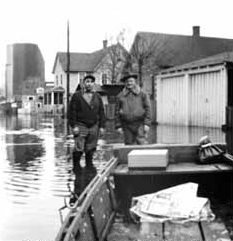|
Situated in lowlands along the river, the Upper Levee and Lower West Side neighborhoods were the first to be threatened by the rising floodwaters. Both had begun as a collection of squatters shacks around the turn of the century, primarily settled by recent immigrants - Irish and Polish along the Upper Levee, Eastern European Jews in the Lower West Side. The riverbank was a place to begin a life in America, but not one at which to stay; although residents along it had direct access to water and, until the late 1920s, fish and recreation, only those who could not afford to do otherwise and move "up the bluff" would live with the frequent floods and increasing pollution. As the first wave of squatters began to move on during the 20s and 30s, they were supplanted by Italians in the Upper Levee (soon denoted "little Italy"), and Chicanos in the Lower West Side. Several years of drought in the 30s enabled further building, and, as the Depression deepened, the river neighborhoods expanded. By 1952, regulated streets and panel homes had mostly replaced the dirt paths and steel shacks of old, and, though still poor, both neighborhoods had firmly established populations of several thousand - all of which had to be evacuated as the waters inexorably rose.  Photo courtesy of MN. Historical Society Applying standard flood methods that it had used the year before, as well as newly devised urban evacuation guidelines (prepared specifically for an atomic blast), the Red Cross began to evacuate the riverside neighborhoods April 9th. Amphibious "Army Ducks," donated from military bases in Wisconsin and Minnesota, cruised from home to home as the waters rose, rescuing people, chickens, dogs, cows, and furniture that eventually filled a downtown warehouse. The Upper Levee was in particular need of assistance, as dikes built by the city after the flood of 1951 had rapidly crumbled under the new year's record flood, leaving residents little time to move belongings to the upper levels of their homes. Not all were preoccupied with the encroaching waters, however, as boys and their dogs spent the afternoons killing rats driven from river land holes. By the 12th, all river bottom residents had been evacuated, some staying with families and friends, but many filling four temporary shelters (two of which had to be relocated when flooded on the 14th and 15th). Staffed by volunteers, including nearly one-hundred area high-school girls babysitting in eight-hour shifts, they provided meals, a bed, and, before citizens returned to their flooded homes, typhoid inoculations. |
Flood of 1952 |
Last updated: November 22, 2019
